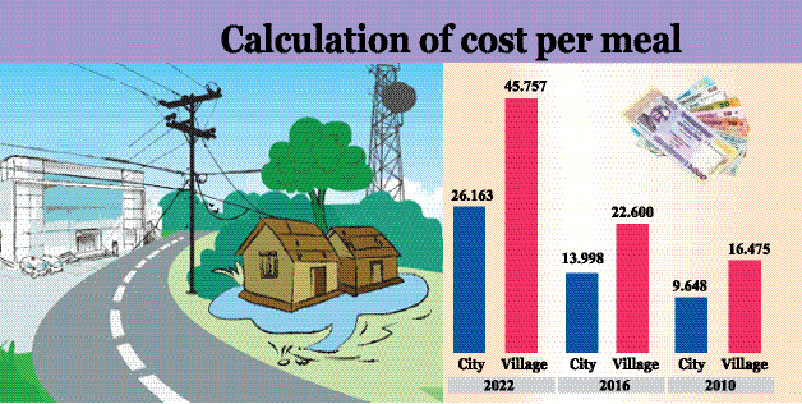Income-expenditure gap of city and village increasing
Mahfuja Mukul: The gap between urban and rural income and expenditure has widened in the last five years. Earlier, the difference in household income between urban and rural areas was Tk 8,000, but now it has increased to Tk 19,000. But in terms of expenditure, the villagers fall short of around Tk 700 per month, due to the nature of their expenditure. The results of the Bangladesh Bureau of Statistics’ Income and Expenditure Survey, released in April, show that as the income gap between urban and rural areas has increased over the past few years, the difference in their expenditure has also been noticeable.
Economists say everything from climate damage to the city’s impact on rural life-forces them to raise consumption levels.
This survey report published on April 12 says that the monthly income of the family in 2022 is Tk 32 thousand 422 at the national level. Income per family in city is Tk 45,757 and in village Tk 26,163. In 2016, the difference in this number was relatively less.
It was Tk 22,600 in the city, and Tk 13,998 in the village.
Income calculation says that in 2022, the difference between city and village per family is Tk 19,594. Where five years ago in 2016 this difference was only Tk 8,602.
Average monthly income of person, town and village
The report of Bangladesh Bureau of Statistics mentions that the average monthly income per capita is Tk 7,614 at the national level. Around Tk 11 thousand in the city, and in the village that income is a little more than Tk 6 thousand. According to the statistics of 2016, at that time the per capita income in the city was a little more than Tk 5,500. And this income in the village was Tk 3,261.
If we determine the difference in income between cities and villages in these five years, it can be seen that in 2022, the per capita difference between urban and rural income was Tk 4860, which was only Tk 2491 in 2016.
Although there is some increase in the city, there is a deficit in the village
According to BSB’s 2022 survey report, the family expenditure at the national level has stood at Tk 31,500. The household expenditure in the city is Tk 41,424. Where the family income is shown as Tk 45,757. That is, the city family has a little more than Tk 4 thousand. Meanwhile, the average expenditure of each family in the village is Tk 26,842, but the income is Tk 26,163. That is, there is a deficit of about Tk 700 between income and expenditure in the village.
Food costs increased
One part of the survey was about the amount spent on average food intake. According to the report, the cost of food per family in the city in 2022 was close to Tk 16,000, which was Tk 8,200 in 2016. That is, the cost of food in the city has almost doubled. Meanwhile, the cost of food in the village was seen to be a little more than Tk 13 thousand, which was Tk 7 thousand in 2016. In other words, the cost here has almost doubled. In 2010, this cost was more than Tk 7 thousand in the city, Tk 5500 in the village.
United Nations Development Program (UNDP) Bangladesh Country Economist Nazneen Ahmed said, “I have seen the findings. The village’s income-expenditure deficit remains. There appear to be several reasons for this. Which factors are mentioned in this survey will be seen later.
But I think most of them move to cities in hopes of higher prices for agricultural produce in rural life. What is left over there (in the village), they have to buy at a high price. This is especially true in villages for those who do not have their own crops and pond fish. Secondly, industrial products that go from cities to villages are sold at higher prices there due to various reasons. There are different levels of places to buy those things in the city.
But because there is no option in the village, people buy them at a higher price. And there are various natural disasters. Starting with fixing up her house in the aftermath of the disaster, her food and living expenses doubled. The people of this city don’t have to worry.
Analyzing the fact that the cost of food has almost doubled in villages and cities in the last 5 years, this economist said, “Earlier the village market used to be held for one or two days a week. Now there is a permanent market and there is a variety of things to buy from food. Parota, Nimki, Singara and Misti have now occupied the place of tea-biscuits in restaurants. Communication with the city is easier than before. All in all, it is normal for the cost of food to increase in the village.
Rare Israeli airstrike in Beirut kills Hezbollah commander and more than a dozen others
International Desk: Israel launched a rare airstrike that killed a senior Hezbollah milita…








